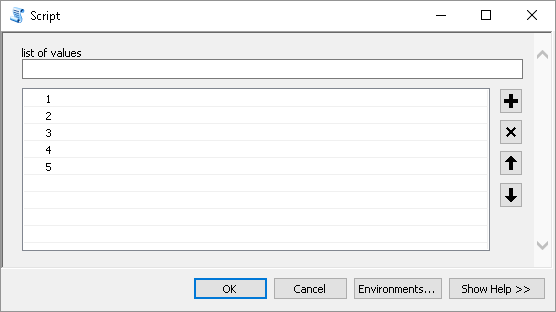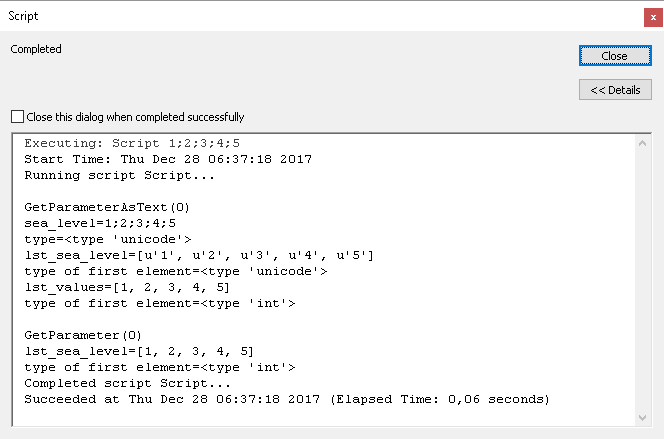- Home
- :
- All Communities
- :
- Developers
- :
- Python
- :
- Python Questions
- :
- Re: how do i use values from a multiple value para...
- Subscribe to RSS Feed
- Mark Topic as New
- Mark Topic as Read
- Float this Topic for Current User
- Bookmark
- Subscribe
- Mute
- Printer Friendly Page
how do i use values from a multiple value parameter into a function
- Mark as New
- Bookmark
- Subscribe
- Mute
- Subscribe to RSS Feed
- Permalink
I want to allow the user to choose several value from a list of values then later i want to use these values to iterate through a raster data set. But very time i keep getting errors saying the data set is not correct. My code is here:
import arcpy,os inputraster = arcpy.GetParameterAsText(0) sea_level = arcpy.GetParameterAsText(1) fc = arcpy.GetParameterAsText(2) clipraster = arcpy.GetParameterAsText valuelist = [x.strip() for x in sea_level.split(";")] for value in valuelist: arcpy.Clip_management(inputraster,"#",clipraster,fc,"#","ClippingGeometry","MAINTAIN_EXTENT") clip_raster = arcpy.Raster(clipraster) floodedarea = os.path.join(outputfolder + "floods" + str(value)) areasbelow = clip_raster <= value areasbelow.save(floodedarea) arcpy.AddMessage(areasbelow)
- Mark as New
- Bookmark
- Subscribe
- Mute
- Subscribe to RSS Feed
- Permalink
a multivalue parameter is often returned as a semi-colon delimited string as you have shown, however, I suspect you are only getting layer names and not paths to files which may be what is needed.
Perhaps you could throw in a few print/arcpy.AddMessage lines in so that you get some output from the tool to examine
- Mark as New
- Bookmark
- Subscribe
- Mute
- Subscribe to RSS Feed
- Permalink
Your value is a string. You will need to convert it to make it numerical by using int or float.
- Mark as New
- Bookmark
- Subscribe
- Mute
- Subscribe to RSS Feed
- Permalink
another argument for using sys.argv instead...
- Mark as New
- Bookmark
- Subscribe
- Mute
- Subscribe to RSS Feed
- Permalink
which variable do i change to int or float is it the valuelist or the value? and I am confused on how to do that
- Mark as New
- Bookmark
- Subscribe
- Mute
- Subscribe to RSS Feed
- Permalink
In case the values are integers you can do this:
valuelist = [int(x.strip()) for x in sea_level.split(";")]- Mark as New
- Bookmark
- Subscribe
- Mute
- Subscribe to RSS Feed
- Permalink
Remember when you obtain a parameter with GetParameterAsText you get it as text, when you use GetParameter you will directly have a list of numeric values. To explain this a little more, please see the example below:
In my tool I collect a list of values:

The script below contains this:
def main():
import arcpy
sea_level = arcpy.GetParameterAsText(0)
arcpy.AddMessage("\nGetParameterAsText(0)")
arcpy.AddMessage("sea_level={0}".format(sea_level))
arcpy.AddMessage("type={0}".format(type(sea_level)))
lst_sea_level = sea_level.split(";")
arcpy.AddMessage("lst_sea_level={0}".format(lst_sea_level))
arcpy.AddMessage("type of first element={0}".format(type(lst_sea_level[0])))
lst_values = [int(v) for v in lst_sea_level]
arcpy.AddMessage("lst_values={0}".format(lst_values))
arcpy.AddMessage("type of first element={0}".format(type(lst_values[0])))
lst_sea_level = arcpy.GetParameter(0)
arcpy.AddMessage("\nGetParameter(0)")
arcpy.AddMessage("lst_sea_level={0}".format(lst_sea_level))
arcpy.AddMessage("type of first element={0}".format(type(lst_sea_level[0])))
if __name__ == '__main__':
main()In the first part it reads the parameter as text and you can see how it is processed to get a list of values. In the second part starting on line 19, I read the same parameter but now directly as a list without converting it to string. The result is this:

In your case it will be much easier to use GetParameter then using GetParameterAsText.
- Mark as New
- Bookmark
- Subscribe
- Mute
- Subscribe to RSS Feed
- Permalink
Thanks let me put in my codes and i will tell you the output